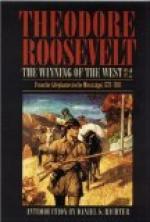True to their customs and traditions, and to their race-capacity for self-rule, the settlers determined forthwith to organize some kind of government under which justice might be done among themselves, and protection afforded against outside attack. Not only had the Indians begun their ravages, but turbulent and disorderly whites were also causing trouble. Robertson, who had been so largely instrumental in founding the Watauga settlement, and giving it laws, naturally took the lead in organizing this, the second community which he had caused to spring up in the wilderness. He summoned a meeting of delegates from the various stations, to be held at Nashborough; [Footnote: It is to Putnam that we owe the publication of the compact of government, and the full details of the methods and proceedings by which it was organized and carried on. See “History of Middle Tennessee,” pp. 84-103.] Henderson being foremost in advocating the adoption of the plan.
In fact, Henderson, the treaty-maker and land-speculator, whose purchase first gave the whites clear color of title to the valleys of the Kentucky and Cumberland, played somewhat the same part, though on a smaller scale, in the settlement made by Robertson as in that made by Boon. He and the Virginian commissioner Walker, had surveyed the boundary line and found that the Cumberland settlements were well to the south of it. He then claimed the soil as his under the Cherokee deed; and disposed of it to the settlers who contracted to pay ten dollars a thousand acres. This was but a fraction of the State price, so the settlers were all eager to hold under Henderson’s deed; one of the causes of their coming out had been the chance of getting land so cheap. But Henderson’s claim was annulled by the legislature, and the satisfaction-piece of 200,000 acres allotted him was laid off elsewhere; so his contracts with the settlers came to nothing, and they eventually got title in the usual way from North Carolina. They suffered no loss in the matter, for they had merely given Henderson promises to pay when his title was made good.
The settlers, by their representatives, met together at Nashborough, and on May 1, 1780, entered into articles of agreement or a compact of government. It was doubtless drawn up by Robertson, with perhaps the help of Henderson, and was modelled upon what may be called the “constitution” of Watauga, with some hints from that of Transylvania. [Footnote: Phelan, the first historian who really grasped what this movement meant, and to what it was due, gives rather too much weight to the part Henderson played. Henderson certainly at this time did not aspire to form a new State on the Cumberland; the compact especially provided for the speedy admission of Cumberland as a county of North Carolina. The marked difference between the Transylvania and the Cumberland “constitutions,” and the close agreement of the latter with the Watauga articles, assuredly point to Robertson as the chief




